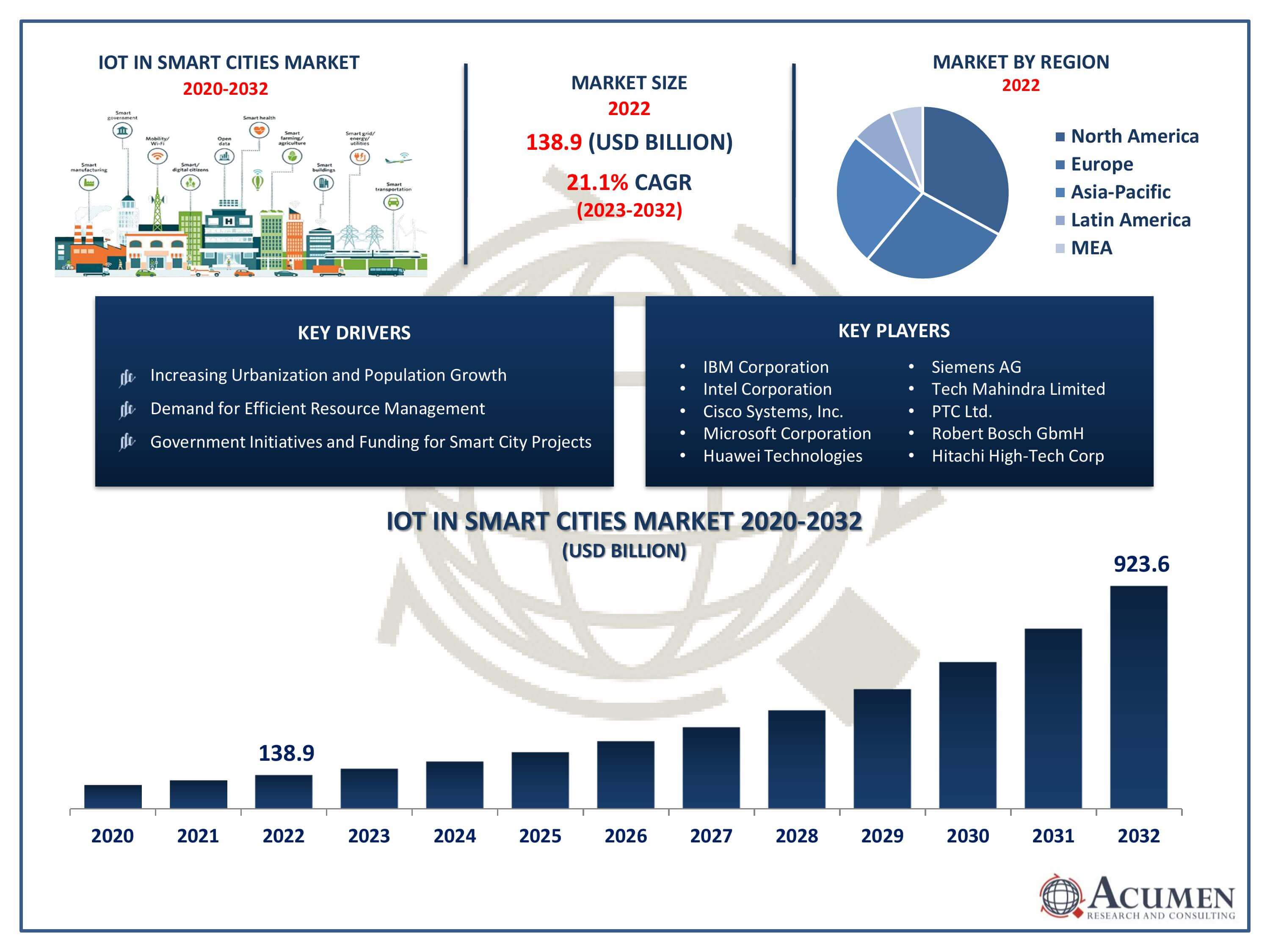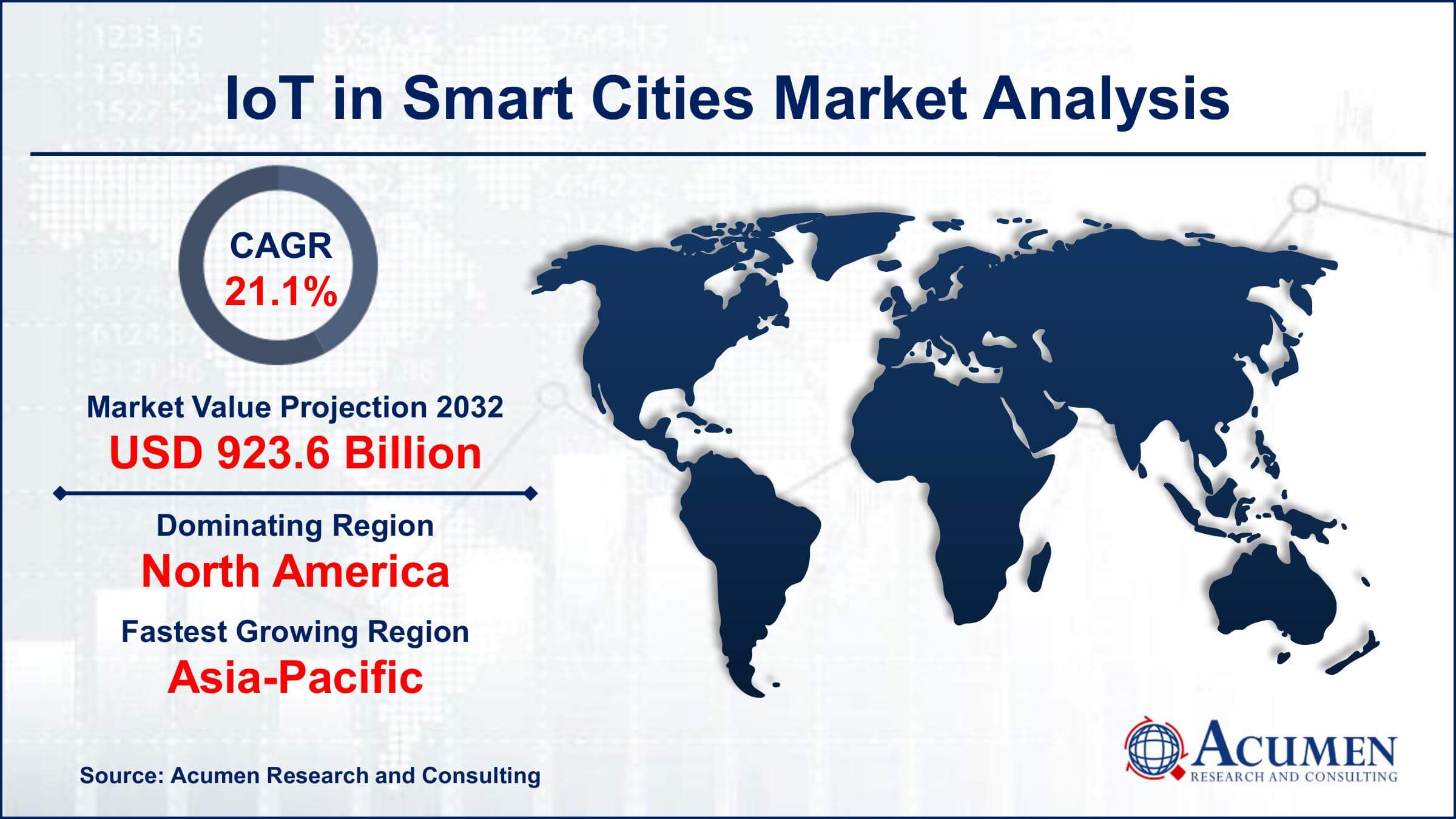March 2025
IoT in Smart Cities Market Size accounted for USD 138.9 Billion in 2022 and is projected to achieve a market size of USD 923.6 Billion by 2032 growing at a CAGR of 21.1% from 2023 to 2032.
The IoT in Smart Cities Market Size accounted for USD 138.9 Billion in 2022 and is projected to achieve a market size of USD 923.6 Billion by 2032 growing at a CAGR of 21.1% from 2023 to 2032.
IoT in Smart Cities Market Highlights
 The internet of things (IoT) plays a pivotal role in the development of smart cities by enabling seamless connectivity and communication between various devices and systems. In the context of smart cities, IoT refers to the network of interconnected devices and sensors embedded in urban infrastructure, such as streetlights, traffic signals, waste management systems, and public transportation. These devices collect and exchange data in real-time, allowing city authorities to make informed decisions, enhance public services, and optimize resource utilization.
The internet of things (IoT) plays a pivotal role in the development of smart cities by enabling seamless connectivity and communication between various devices and systems. In the context of smart cities, IoT refers to the network of interconnected devices and sensors embedded in urban infrastructure, such as streetlights, traffic signals, waste management systems, and public transportation. These devices collect and exchange data in real-time, allowing city authorities to make informed decisions, enhance public services, and optimize resource utilization.
The market growth of IoT in smart cities has been significant and is expected to continue its upward trajectory in the coming years. The increasing urbanization, coupled with the need for sustainable and efficient urban solutions, is driving the demand for IoT technologies in smart cities. Market research reports indicate a substantial growth in the adoption of IoT devices and solutions by city governments and urban planners. These technologies not only enhance the quality of life for citizens but also offer cost-effective solutions for managing and maintaining urban infrastructure. Additionally, advancements in IoT technology, such as the development of low-power, long-range communication protocols and edge computing, are further fueling the market growth, making IoT an integral part of the smart city ecosystem.
Global IoT in Smart Cities Market Trends
Market Drivers
Market Restraints
Market Opportunities
IoT in Smart Cities Market Report Coverage
| Market | IoT in Smart Cities Market |
| IoT in Smart Cities Market Size 2022 | USD 138.9 Billion |
| IoT in Smart Cities Market Forecast 2032 | USD 923.6 Billion |
| IoT in Smart Cities Market CAGR During 2023 - 2032 | 21.1% |
| IoT in Smart Cities Market Analysis Period | 2020 - 2032 |
| Base Year |
2022 |
| Forecast Data | 2023 - 2032 |
| Segments Covered | By Component, By Application, And By Geography |
| Regional Scope | North America, Europe, Asia Pacific, Latin America, and Middle East & Africa |
| Key Companies Profiled | IBM Corporation, Intel Corporation, Cisco Systems, Inc., Microsoft Corporation, Huawei Technologies Co., Ltd., Siemens AG, Tech Mahindra Limited, PTC Ltd., Robert Bosch GbmH, Hitachi High-Tech Corporation, Schneider Electric Infrastructure Ltd., and SAP SE. |
| Report Coverage |
Market Trends, Drivers, Restraints, Competitive Analysis, Player Profiling, Covid-19 Analysis, Regulation Analysis |
IoT technology plays a crucial role in transforming traditional cities into smart cities by enabling efficient resource management, reducing operational costs, enhancing public safety, and optimizing various services. One of the key applications of IoT in smart cities is in urban mobility. IoT-enabled sensors and devices are integrated into public transportation systems and road networks, providing real-time information about traffic flow, public transit schedules, and parking availability. This data is not only valuable for city planning but also for commuters, allowing them to make informed decisions about their travel routes and modes of transportation, thereby reducing congestion and improving overall mobility efficiency. Additionally, IoT technology is extensively used in environmental monitoring, where sensors measure air and water quality, noise levels, and other environmental parameters. This information is vital for managing pollution, conserving natural resources, and creating sustainable urban environments.
The IoT market in smart cities is experiencing robust growth, driven by the increasing adoption of smart technologies to address urban challenges. As more cities around the world embrace the concept of smart cities, the demand for IoT solutions continues to rise. One of the significant factors fueling this growth is the pressing need for efficient urban infrastructure and resource management. IoT-enabled devices and sensors provide real-time data on various aspects of city life, including traffic flow, energy consumption, waste management, and public safety. By analyzing this data, city authorities can make data-driven decisions to optimize services, reduce costs, and enhance the overall quality of life for citizens. Furthermore, the expanding use and expansion of IoT in construction market, as well as considerable growth in the smart home market, are driving the IoT in smart cities market.Additionally, advancements in IoT technology, such as the development of low-power, wide-area networks (LPWAN) and edge computing, have expanded the capabilities of IoT devices.
Integration of IoT with 5G Networks Creates Lucrative Opportunity for IoT in Smart Cities Market
The revenue of the global 5G IoT market is projected to surge by USD 643 billion by 2032, exhibiting an impressive CAGR of 67.8% from 2023 to 2032. 5G IoT, short for 5G internet of things, brings together the power of fifth-generation mobile networks and IoT technology. It merges the lightning-fast speed, minimal delay, and extensive connectivity of 5G networks with the wide array of IoT devices. This allows devices, sensors, and systems to communicate effortlessly. Thanks to 5G IoT, devices can share data instantly, which is perfect for applications in smart cities.
Rising Number of Smart Cities Creates Demand for IoT Technology Industry
The global smart cities market is on track to reach impressive revenue of USD 5,974.9 billion by 2032, showing a remarkable growth rate of 25.8% from 2023 to 2032. Smart cities are shaping the future of urban living. According to United Nations data, it's anticipated that 70% of the world's population will reside in smart cities by 2050. While there isn't a single definition for a smart city, it's estimated that there are already over 140 worldwide, and this number is rapidly increasing. The widespread availability of high-speed internet, along with the rising use of connected devices across various sectors, is driving the expansion of this market. Moreover, substantial government investments in smart city initiatives aim to enhance citizens' quality of life, provide better opportunities, and develop cities with advanced infrastructure to create cleaner and more sustainable living environments.
IoT in Smart Cities Market Segmentation
The global IoT in smart cities market segmentation is based on component, application, and geography.
IoT in Smart Cities Market By Component
In terms of components, the solution segment accounted for the largest market share in 2022. This segment is further categorized into security management, location analytics, remote monitoring systems, real-time streaming analytics, reporting and analytics, and data management solutions. One of the key areas driving this growth is smart infrastructure. IoT solutions in this segment include sensors and connected devices embedded in buildings, roads, and utilities, enabling efficient management of resources. Smart infrastructure solutions monitor the health of bridges, roads, and public buildings in real-time, allowing authorities to proactively address maintenance needs, ensuring public safety and prolonging the lifespan of critical assets. Another significant growth area is smart mobility. With the rise of urbanization, cities are grappling with traffic congestion and transportation inefficiencies. IoT-enabled solutions in smart mobility include connected vehicles, intelligent traffic management systems, and real-time public transportation tracking.
IoT in Smart Cities Market By Application
According to the IoT in smart cities market forecast, the smart building segment is expected to witness significant growth in the coming years. Smart buildings leverage IoT technologies to optimize energy usage, improve security, and enhance overall occupant comfort. One of the key drivers of growth in this segment is the increasing focus on energy efficiency. Smart buildings incorporate IoT sensors and automation systems to monitor and control lighting, heating, ventilation, and air conditioning (HVAC) systems in real-time. By analyzing occupancy patterns and environmental conditions, these buildings can adjust energy usage dynamically, leading to significant energy savings and reduced carbon emissions, aligning with the sustainable goals of smart cities. Enhanced occupant experience is another major factor fueling the growth of smart buildings in the IoT-driven smart cities landscape. Moreover, the integration of smart building systems with city-wide infrastructure is contributing to the growth of this segment. Smart buildings are becoming integral components of larger urban ecosystems, connecting with transportation, energy grids, and emergency services.
IoT in Smart Cities Market Regional Outlook
North America
Europe
Asia-Pacific
Latin America
The Middle East & Africa

IoT in Smart Cities Market Regional Analysis
Geographically, North America is dominating the IoT in the smart cities market in 2022. This growth is attributed to the regions robust technological infrastructure and early adoption of IoT technologies, supportive government initiatives and policies, and a high level of investment from both public and private sectors. The region is home to many tech giants and startups specializing in IoT, leading to the development of cutting-edge solutions tailored for urban environments. This technological prowess allows cities in North America to swiftly deploy and integrate IoT devices and systems, addressing various urban challenges effectively. Moreover, many North American governments have been proactive in promoting smart city projects by offering grants, incentives, and funding. Federal and local authorities have collaborated with private sector companies, creating a conducive environment for IoT innovation. This support has encouraged the development and implementation of IoT solutions in areas such as transportation, healthcare, energy management, and public safety, contributing significantly to the region's dominance in the market.
Nevertheless, the Asia-Pacific region is expected to grow significantly from 2023 to 2032. The main reason is the increasing number of smart cities in Asia. Some of the region's top smart cities include Hangzhou, Kuala Lumpur, Seoul, Busan, Hong Kong, and Singapore. Furthermore, rapidly increasing investments in smart city projects will accelerate the adoption of IoT in smart cities. According to data from the India Investment Grid Organization, India will invest USD 26.38 billion in over 1131 smart city projects as part of its Smart City Mission by 2023.
IoT in Smart Cities Market Player
Some of the top IoT in smart cities market companies offered in the professional report include IBM Corporation, Intel Corporation, Cisco Systems, Inc., Microsoft Corporation, Huawei Technologies Co., Ltd., Siemens AG, Tech Mahindra Limited, PTC Ltd., Robert Bosch GbmH, Hitachi High-Tech Corporation, Schneider Electric Infrastructure Ltd., and SAP SE.
Looking for discounts, bulk pricing, or custom solutions? Contact us today at sales@acumenresearchandconsulting.com
March 2025
May 2023
May 2024
January 2023